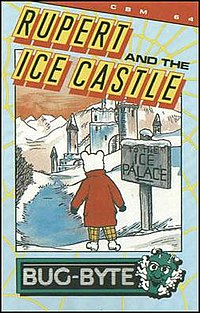
Chip 'n Dale: Rescue Rangers is an American animated adventure comedy television series produced by Walt Disney Television Animation. Created by Tad Stones and Alan Zaslove, it featured established Disney characters Chip 'n' Dale in a new setting. After the episode "Catteries Not Included" aired on August 27, 1988 as a preview, the series premiered on The Disney Channel on March 4, 1989. The series continued in syndication in September 1989 with a two-hour special, Rescue Rangers: To the Rescue, later divided into five parts to air as part of the weekday run. On September 18, 1989, the series entered national syndication. It often aired on afternoons along with DuckTales, and beginning on September 10, 1990, as a part of the syndicated programming block The Disney Afternoon. The final episode aired on November 19, 1990.

Rupert Bear is an English children's comic strip character and franchise created by Herbert Tourtel and illustrated by his wife, the artist Mary Tourtel, first appearing in the Daily Express newspaper on 8 November 1920. Rupert's initial purpose was to win sales from the rival Daily Mail and Daily Mirror. In 1935, the stories were taken over by Alfred Bestall, who was previously an illustrator for Punch and other glossy magazines. Bestall proved to be successful in the field of children's literature and worked on Rupert stories and artwork into his nineties. More recently, various other artists and writers have continued the series. About 50 million copies have been sold worldwide.

Ice Climber is a platform game developed and published by Nintendo. It was released in 1985 for both the arcade VS. System and the Famicom / Nintendo Entertainment System console. The characters Popo and Nana, known as the Ice Climbers, scale 32 vertically scrolling, ice-covered mountains to recover stolen vegetables from a giant condor. In some European countries, Ice Climber was bundled with the Nintendo Entertainment System.
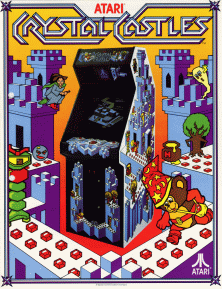
Crystal Castles is an arcade video game released by Atari, Inc. in 1983. The player controls Bentley Bear who has to collect gems located throughout trimetric-projected rendered castles while avoiding enemies, some of whom are after the gems as well.
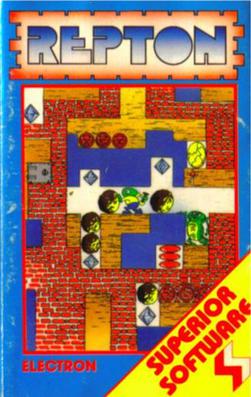
Repton is a video game originally developed by 16-year-old Briton Tim Tyler for the BBC Micro and Acorn Electron and released by Superior Software in 1985. The game spawned a series of follow up games which were released throughout the 1980s. The series sold around 125,000 copies between 1985 and 1990 with Repton 2 selling 35,000 itself. The games have since been remade for several modern systems, including iRepton for the iPhone / iPod Touch in 2010, and Android Repton 1, Android Repton 2 and Android Repton 3 from 2016 to 2018.

Underwurlde is a 1984 action-adventure platform video game in the Sabreman series by Ultimate Play the Game for the ZX Spectrum and Commodore 64. The player controls the adventurer Sabreman as he jumps between platforms in a castle and its caverns to find an escape past the exit guardians. Underwurlde features about 600 flip screen areas. Unlike other games of its time, Sabreman is not injured when touched by enemies and is instead knocked backwards. Underwurlde is the second game in the series, between Sabre Wulf and Knight Lore, and released shortly before the latter for the ZX Spectrum in late 1984. Another developer, Firebird, ported the game to the Commodore 64 the next year.

The Horace video game series was created in the 1980s by William Tang for Beam Software. The series comprised Hungry Horace, Horace Goes Skiing and Horace and the Spiders.

Yie Ar Kung-Fu is an arcade fighting game developed and published by Konami. It first had a limited Japanese release in October 1984, before having a wide release nationwide in January 1985 and then internationally in March. Along with Karate Champ (1984), which influenced Yie-Ar Kung Fu, it is one of the games that established the basis for modern fighting games.
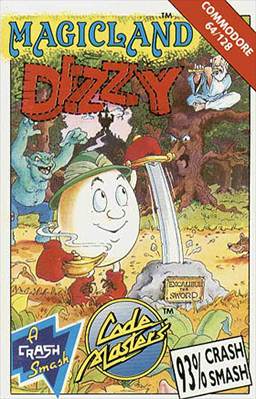
Magicland Dizzy is a platform adventure game published in Europe in 1990 by Codemasters for the ZX Spectrum, Commodore 64 and Amiga platforms. By 1992 there were also MS-DOS, Atari ST and Amstrad CPC versions available. It is the sixth game in the Dizzy series, and the fourth adventure-based Dizzy title. The story, set in a fantasy world called Magicland, follows on from the events of Fantasy World Dizzy, the previous adventure title. In Magicland Dizzy the player controls Dizzy, an egg-shaped character, who is trying to save six of his friends who have been placed under spells by the Evil Wizard Zaks.

Doomdark's Revenge is a role-playing and wargame video game developed by Mike Singleton and published by Beyond Software for the ZX Spectrum in 1984. It is a sequel to Singleton's 1984 seminal The Lords of Midnight and has similar game mechanics but adds more detail and complexity with the number of characters and locations increased.

Rupert is a 2D traditionally animated children's television series based on the Mary Tourtel character Rupert Bear, which aired from 1991 to 1997 with 65 half-hour episodes produced. The series is produced by Nelvana, in co-production with Ellipse Programme for the first three seasons, in association with YTV Canada, Inc., and ITV franchisees TVS Television and Scottish Television.
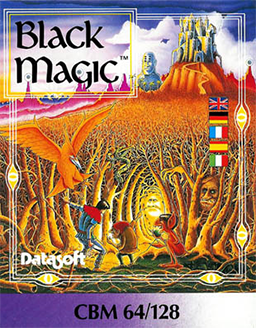
Black Magic is a multidirectional scrolling action-adventure game written for the Apple II by Peter Ward of Action Software and published by Datasoft in 1987. Commodore 64, ZX Spectrum, and Amstrad CPC versions were also released.

Hunchback is a video game developed by Century Electronics and published in arcades in 1983. The game is loosely based on the 1831 Victor Hugo novel The Hunchback of Notre-Dame and the player controls Quasimodo. Set on top of a castle wall, the player must guide the Hunchback from left to right while avoiding obstacles on a series of non-scrolling screens. The goal of each screen is to ring the church bell at the far right.

Action Force: International Heroes is a video game released by Virgin Games in 1987 for the ZX Spectrum and Commodore 64, and in 1988 for the Amstrad CPC. The game is set in the world of the Action Force toys by Hasbro. The ZX Spectrum version of the game differs notably from the Commodore and Amstrad versions.

Rupert and the Toymaker's Party is a video game developed by Martin Walker and published by Quicksilva in 1985. It was developed for the Commodore 64 and ZX Spectrum.

Batman is an action video game developed and published by Ocean Software based on the 1989 film of the same name. It was released on 11 September 1989 for the Commodore 64 and ZX Spectrum with Amiga, Amstrad CPC, Atari ST, MS-DOS and MSX versions following soon after.
Anna of Arendelle is a fictional character who appears in Walt Disney Animation Studios' animated fantasy film Frozen (2013) and its sequel Frozen II (2019). She is voiced by Kristen Bell as an adult. At the beginning of the film, Livvy Stubenrauch and Katie Lopez provide her speaking and singing voice as a young child, respectively. Agatha Lee Monn portrayed her as a nine-year-old (singing). In Frozen II, Hadley Gannaway provided her voice as a young child while Stubenrauch is the archive audio.

Olaf is a fictional character in Disney's Frozen franchise. He first appeared in the Walt Disney Animation Studios animated film Frozen (2013). At the beginning of the film, Olaf is an inanimate snowman created by Elsa and Anna in their childhood. He then reappears in the film as an anthropomorphic snowman created by Elsa's ice powers, and helps Anna and Kristoff in their journey to find Elsa. He later appears in other related Frozen media, including the sequel Frozen II (2019), and serves as the central character in the featurette Olaf's Frozen Adventure (2017), the short film Once Upon a Snowman (2020), and the series of shorts Olaf Presents (2021). He is voiced by Josh Gad in most of his appearances.
Lego Disney is a Lego theme based on the various Disney Princesses and Disney characters involved in different Disney films and television series. It is licensed from Walt Disney Pictures. The theme was first introduced in 2016 and was re-branded theme from the Lego Disney Princess line in 2017. The toy line was accompanied by several shorts and television specials based on Lego Disney.
